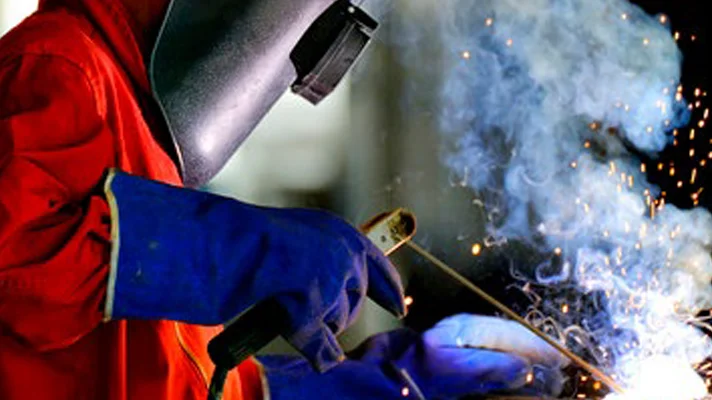Secure your future today!
Welding and Cutting Best Practices

Nearly every manufacturer, and many other businesses, use welding in production or maintenance as part of their operation. To weld safely, a welder needs to consider the welding method, amount of welding, metal that is being welded, and duration of the weld.
Welding Hazards
Hazards associated with welding include:
- Respiratory hazards from inhalation of fumes. Welders must know what metal they are working on to understand the exposures and control them properly.
- Overexposure to welding or arc flash can lead to eye pain, tearing or reddening, a feeling of sand in the eye, or other vision issues. The eyes of everyone in the area are at risk.
- Other physical hazards like cuts from sharp metal, being struck by objects that fall off tables or cranes, burns from hot metal, or strains from handling heavy metal parts.
- Fire or explosion hazards from storage and handling of fuel cylinders and oxygen.
Make sure employees are wearing proper eye protection and clothing. Eye protection includes safety goggles and helmets. Clothing should be made from heavyweight, tightly woven, 100% wool or cotton to protect from UV radiation, hot metal, sparks, and open flames. Keep in mind that flame retardant treatments become less effective with repeated laundering. Other helpful clothing includes gloves and steel toe shoes to reduce the risk for a serious foot injury from falling heavy objects. Hard hats may be required if objects are handled more than 5 feet off the ground.
Best Practices
- Hexavalent chromium presents a higher respiratory risk when welding. Make sure to follow special practices when welding stainless steel or material that contains hexavalent chromium.
- Use welding screens to protect people in adjacent areas from eye injuries caused by incidental exposure to welding work. Screens should be mounted about 1 foot off the floor and arranged so that they do not restrict ventilation and air flow.
- Maintain adequate air flow and ventilation to capture and vent fumes to a safe location.
- If a respirator is worn, make sure that it’s proper for the welding fumes, is worn correctly, and is stored and maintained properly. Anyone wearing a respirator must be fit tested and have an annual medical exam to make sure that they can wear the respirator without additional complications.
- Make sure that parts are secure when lifting with a crane or hoist. Get help to lift large or bulky parts manually.
- Don’t forget the height and layout of the welding table and workstation. Try to provide a support where the average person can stand and weld without bending over — about 28 to 35 inches high for the general population. Provide space around stations for the person to move and weld without reaching over a piece of material.
- Do not gas weld or cut in or near rooms or locations where flammable liquids or vapors, lint, dust, or other combustible material is located, to reduce the risk for sparks to ignite material.
- Keep one or more fire extinguishers in any location where welding is conducted. Extinguishers must be accessible and properly serviced.
- Store and handle compressed gas cylinders properly to reduce the risk for an explosion or fire.
- Some welding processes, like plasma torch cutting or inert gas shielded arc welding, are special processes requiring manufacturer’s recommendations with regard to safety procedures and personal protective equipment.
See our related Safety Bulletin for more
Download This Article
Additional Safety Topics
Check Out All Our Products
Commercial Insurance Built for You
We offer a wide range of Commercial insurance products. Find the product that's right for you!
Specialty Insurance
Commercial Auto Insurance Workers' Compensation Insurance Manufacturing Insurance Insurance for WineriesConstruction and Contracting
General Contractor Insurance Carpenters Insurance Plumbing Insurance Excavator Insurance Electrician Insurance HVAC Business Insurance Lawn Care Business InsuranceRetail and Service
Retail Business Insurance Barber Insurance Pet Grooming Insurance Florist Insurance Bakery Insurance Photographer Insurance Beautician Insurance Coffee Shop Insurance Funeral Home Insurance Janitorial InsuranceGet Insurance for Your Car and Home
You need to protect more than just your business. Get insurance for your personal property too!
Personal Lines InsuranceWe've Got You Covered!
We offer Personal Lines Insurance in five states: Ohio, Michigan, Illinois, Indiana, and Wisconsin.
Insurance for All Types of Farms
Hastings offers a range of products specifically designed for farmers.
Farm InsuranceWe've Got You Covered!
We offer Farm Lines Insurance in five states: Ohio, Michigan, Illinois, Indiana, and Wisconsin.
Secure your future today!
Hastings Insurance Company
404 E. Woodlawn Ave.
Hastings, MI 49058
Monday-Friday
8:00 a.m. - 4:30 p.m. (EST)
(800) 442-8277
Terms of Use and Privacy Statement© Hastings Insurance Company. All rights reserved.



